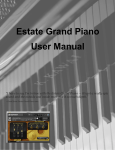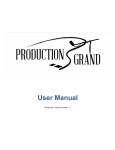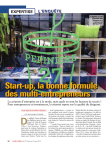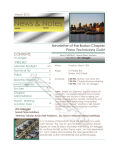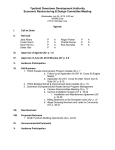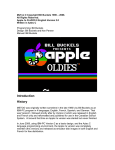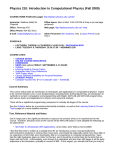Download PDF Estate Grand for sforzando User Manual
Transcript
Estate Grand for sforzando User Manual “I have to say I’m in love with the Estate Grand Piano — it’s got a really epic sound and the outside and inside mics give it so much depth.” ~ Email from Estate Grand Piano user. Estate Grand User Manual Description Production Voices' Estate Grand Piano for sforzando is a beautifully sampled Kawai GS60 6'9" grand piano. Estate Grand for sforzando is extremely flexible in sound and use. It gives exceptional results in live performance, production work in the studio, songwriting, film scoring, practicing and more! It was recorded with care and with only the finest equipment at a country estate in the heart of corn country in Southern Ontario, Canada. Note: This is the standalone sforzando/Aria version of our popular Estate Grand Piano. Estate Grand is also available for Native Instruments Kontakt (purchased separately). How does it sound? The Estate Grand Piano is sampled from a grand piano that resides in the library of a country manor. The room is warm sounding and the piano overpowers the room just slightly filling the room with strong overtones. The piano has a lot of attack and will cut through just about any mix! While sampling the grand piano, the owner of the manor mentioned that he auditioned several pianos before picking the Kawai. He had tried Steinways and other famous pianos, but fell in love with the character of the Kawai. It is not a "me too" piano, but a unique instrument that will add life to your live or recorded piano sound! Instrument Features • • • • • • • • • 11+ GB Sample Size uncompressed. Delivered in lossless FLAC compressed format around 3.8GB. Up to 10 velocity layers per key (Up to 25 samples per note: Pedal up, down and release samples). 3 stereo microphone positions controllable by the user. Full pedal down and pedal up samples. Over 4200 samples! Authentic sustain pedal up and down noises! Controllable keyboard action/mechanism noises. Independent control over stereo microphone pairs! Recorded at 24 bit 44.1 kHz with incredible detail and fidelity through Apogee Symphony I/O, Neumann and Rode microphones. System Requirements Minimum System Plogue sforzando or Aria Player required. Plogue sforzando is available for FREE here: http://www.plogue.com/products/sforzando/ Estate Grand for sforzando Minimum Requirements: Multi-core Intel i3, i5, i7 or better recommended 8 GB RAM 64 bit operating system (Mac OS X or Windows) 6 GB of hard drive space for compressed samples. 7200 rpm or better non-system hard drive ESTATE GRAND USER MANUAL 2 Note: Multi-microphone and multi-gigabyte sample libraries, such as Estate Grand, can be taxing and unusable on systems not meeting the minimum requirements. Recommended System 16 GB RAM or more. Fast hard drive: 7200 rpm, RAID or SSD. Multi-core Intel i5 processor or better. 64 bit operating system and plugin host. Getting Started Installing Estate Grand for sforzando Installation of Estate Grand for sforzando is fairly straightforward: 1. Download and install sforzando: http://www.plogue.com/products/sforzando/ 2. Download Estate Grand for sforzando and unzip. 3. Place the “Estate Grand for sforzando” folder on the drive that you wish to run it from. Any fast hard drive will work. If available, we recommend an SSD solid state drive for best performance. 4. Launch sforzando with the setting shown in the next section. 5. Drag the “Estate Grand.bank.xml” file from within the “Estate Grand for sforzando” folder onto sforzando. This registers your purchase with sforzando and puts the presets into sforzando. Plogue sforzando Settings Before Loading Before loading Estate Grand, set the following recommended settings: 1. Select the “SETTINGS” tab. 2. Set POLY. To 128. 3. Set “Max Engine RAM Allocatior” to 2 GB. This can be set lower on systems that have less RAM, but performance will be affected. 4. Set “Inst. Disk Pre-Caching” to 64 kB. This will load 64 kB of every sample into RAM as a buffer before streaming the samples from the hard drive. Loading Estate Grand Presets Once Estate Grand for sforzando is installed, the presets will show up under the file menu. The presets are divided into two types: 1 Estate Grand Piano and 2 Estate Grand Piano LE. The 1 Estate Grand Piano presets are full memory presets using all of the samples. With the exception of 1 Estate Grand Piano, which loads all the microphone perspective, listed after the presets are the microphone perspectives that will be loaded. 1 Estate Grand Piano – Full Edition that loads all the samples. Most users will load and use this preset the most. 2 Estate Grand Piano IN – Just the inside microphones. Use this preset to save memory if you intend not to use MS or RM. 3 Estate Grand Piano MS – Just the mid-side microphones. Use this preset to save memory when not using IN or RM. 4 Estate Grand Piano RM – Just the room microphones. Use this preset to save memory when not using IN or MS. 5 Estate Grand Piano IN+RM – A combination of just the Inside and Room microphones. The 2 Estate Grand Piano LE presets are the Light Edition presets that use about half the memory or less compared to the full presets. These LE presets will also load about twice as fast. The LE presets, however, use less than half the samples. So, they are not a detailed as the Full version presets. The LE presets have the same variations as the Full presets which can load only the microphone perspectives that you need you save addition memory and load time. Laptop touring musicians may find that the 2 Estate Grand Piano LE IN preset works great on stage and loads fast. ESTATE GRAND USER MANUAL 4 Estate Grand Controls Microphone Perspectives: IN - Microphones placed inside the piano for a strong crisp sound! M/S - Microphones just outside the piano for a balanced open piano and room sound! ROOM - Microphones picking up a beautiful warm balance of mostly room and some direct piano sound. ESTATE GRAND USER MANUAL 5 IN - The inside microphones can be used on their own or blended with any of the other microphone perspectives. The inside microphones will probably be your first go-to mics and the most used of the microphone perspectives. These mics give the typical recorded piano sound. M/S - M/S stands for middle/side, which is a form of stereo miking. This microphone pair was placed just outside the open piano lid in the crook of the piano. It blends both the presence of the piano and the ambience of the room. It is probably best not to use this microphone perspective on its own, but rather to use it to blend in with either the inside or room mics. It can add warmth and space to the inside mics or a little more attack and edge to the room mics. Room - The room microphone perspective is great for a lounge feel or for classical music where a more natural open sound is desired. It blends well with the other microphone perspectives. Experimenting with the balances of the three microphone perspectives is the best way to hear how Estate Grand can sound. The flexibility of sound and control that the user has over the sound is quite remarkable. Make sure to try different levels and settings. When in doubt, start with the inside microphones. Microphone Off/On Buttons The buttons below the microphone name will turn on and off the samples for that microphone. Turning off unused microphones can save computer resources. We recommend just turning the volume down on the different perspectives when setting up your sound. After you have set your sound levels and are using the piano, if any perspective is not being used, turning the unused perspective off will save CPU resources. Remember, with all three microphone perspectives active, three stereo samples are triggered for every single note played. Mixer: The top represents unity gain or 0.0 dB. This is where the fader is neither adding nor subtracting volume from the sound. This is the ideal fader position for your loudest microphone perspective. Production Tip: The faders can be automated in a DAW such as Logic or Pro Tools. MIDI controller numbers are pre-assigned to the faders and controls and cannot be reassigned. Automating the faders can allow for creative sounds such as morphing the room sound into the inside microphones in a bridge section of a song, for example. Another use of automation might be to give a solo piano section more room sound and give more of inside mic sound on the piano once the band or other instruments come back in, or vise versa. This is something that a producer or mix engineer might do with a real recorded piano. Now you can do the same with samples! ESTATE GRAND USER MANUAL 6 Mechanical Noises: Pedal Noise: Sustain pedal mechanical noise. The pedal noise controls the volume of the sound of the foot depressing and releasing the sustain pedal. Here the dampers activate the strings in the piano and then stop the strings with a subtle thud sound when released. There is an on/off button for the pedal noise. Most workstation keyboards do not have this sound! But it is the easiest way to add realism to your sampled piano. Pedal Noise Tips: Busy mixes, such as songs with many instruments, may mask (cover up) the pedal noise. In this case, it can be turned off to save voice count. On solo or sparse arrangements, consider increasing the pedal noise to give a more intimate sound. Key Up: Key Up controls the volume of the keyboard action sound as a key is released (The hammer returning). It is only triggered when the sustain pedal is down and a key is released. This is a subtle sound that is barely heard even at the maximum volume, but it adds that extra touch of realism. You might be asking: “Why only when the pedal is down and when a key is released? Why not when the pedal is off as well?” These are good questions! The Key Up sample is a natural part of the Key Release samples. In a busy production or song, the Key Ups may not be heard. There is a button to turn the Key Ups off. Key Release: Key Release is the volume control for samples triggered when a key is released or the pedal is let up when a note was sustaining from the pedal, but no key is held. This is the sound of the dampers stopping the piano string from ringing. ESTATE GRAND USER MANUAL 7 The key releases are the most detailed of all the samples taken, having the most velocities. This gives a realistic sound to the stopping of a note that just isn’t achievable with ADSR release envelopes. Users can vary how loud they like the key release samples. The longer you sustain a note in isolation, the more likely it is that you will hear the key release when a key is released. All of the mechanical noises can add up to create an authentic piano sound that will surpass (and in many cases, blow away) most current keyboard workstations or digital pianos. ***NOTE*** The Estate Grand Piano was professional scripted to have a smart release for the pedal samples. Release samples are only played on the notes that are not sustained. When a note is struck, the pedal is depressed and the note is released, it will still sustain. But… when the pedal is released, a proper release sample is played. Miscellaneous Release Versions Estate Grand Version 1.0 – Initial Release Estate Grand Strengths The Estate Grand really cuts through a mix! It has an edge to it that works well in pop music productions as well as other music genre productions. ESTATE GRAND USER MANUAL 8 Estate Grand Known Issues Sampling in the country presents its challenges! There are the birds and wildlife outside as well as the sounds of the manor creaking as it heats up with sun's heat and cools as the sun sets. The piano took several days to sample and countless hours to edit. If you listen closely, you may hear the rustling of leaves and a bird or two on the quietest of notes, but that's only if you listen intently enough to hear if we actual sampled the piano in an estate! Support Contact us by email: [email protected] Credits Audio Engineering, Editing, Programming: Jason Chapman www.productionvoices.com Interface controls: Shannon Penner www.plunkandboom.ca Graphic Design: Rob Selenis www.pixelcom.com License Agreement Estate Grand is licensed, not sold, to the end user. The complete license agreement can be found here: http://www.productionvoices.com/terms-and-conditions/ Legal Notice Production Voices is in no way associated with Plogue, Native Instruments or Kawai. sforzando, Aria Engine, Kontakt and Kawai GS60 are trademarks of their respective owners and are not associated with Production Voices. Estate Grand for sforzando is © 2015 Production Voices. ESTATE GRAND USER MANUAL 9









